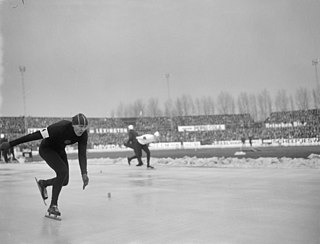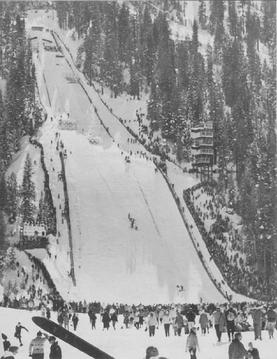
The 1960 Winter Olympics were a winter multi-sport event held from February 18 to 28, 1960, at the Squaw Valley Resort in Squaw Valley, California, United States. The resort was chosen to host the Games at the 1956 meeting of the International Olympic Committee (IOC). Squaw Valley was an undeveloped resort in 1955, so the infrastructure and all of the venues were built between 1956 and 1960 at a cost of US$80,000,000. The layout was designed to be intimate, allowing spectators and competitors to reach most of the venues on foot.
Figure skating at the 1960 Winter Olympics took place at the Blyth Arena in Squaw Valley, California, United States. Three figure skating events were contested: men's singles, ladies' singles and pair skating. It was the final time that figure skating at the Winter Olympics was conducted in a covered, but not enclosed, rink.

Australia competed at the 1960 Winter Olympics in Squaw Valley, United States. This was the first and last time Australia competed in ice hockey and Nordic combined. While ice hockey gave Australia its only top ten finish in this games, the team lost all of their matches, conceding double-digit goals. Australia also competed in alpine skiing, cross-country skiing, and figure skating, where Mervyn Bower and Jacqueline Mason came twelfth in the pairs event.
Maria Jelinek is a Canadian former pair skater. With her brother Otto, she is the 1962 World champion, the 1961 North American champion, and 1961–1962 Canadian national champion. They represented Canada at the 1960 Winter Olympics, where they placed 4th.

Viktor Ivanovich Kosichkin was a speed skater who competed for the Soviet Union.
The men's singles was one of four events in figure skating at the 1908 Summer Olympics. Each nation could enter up to 3 skaters. Sweden's Ulrich Salchow, who had won several World Figure Skating Championships, easily won the gold medal after his main rival, Russia's Nikolai Panin, withdrew either in protest over what he considered unfair judging or due to illness.
The ladies' singles was one of four events in figure skating at the 1908 Summer Olympics. Each nation could enter up to 3 skaters. Without rivals Jenny Herz and Lily Kronberger present at the Olympics, Great Britain's Madge Syers easily won the gold medal.
The mixed pairs was one of four events in figure skating at the 1908 Summer Olympics. Each nation could enter up to 3 pairs. Twelve years later, silver medalist Phyllis Johnson would capture a bronze medal with a new partner at the 1920 Olympics.
Ski jumping at the 1960 Winter Olympics consisted of one event held on 28 February, taking place at Papoose Peak Jumps.

Denmark sent a delegation to compete at the 1960 Winter Olympics in Squaw Valley, United States from 18–28 February 1960. This was Denmark's third time participating in a Winter Olympic Games. The only athlete the nation sent to these Games was speed skater Kurt Stille. He competed in the men's 1,500, 5,000, and 10,000 meter events, finishing 13th, 27th, and 17th respectively.

Figure skating at the 2010 Winter Olympics was held at the Pacific Coliseum in Vancouver, British Columbia, Canada. The events took place between 14 and 27 February 2010.
The women's 1500 metres speed skating event was part of the speed skating at the 1960 Winter Olympics programme. It was the first appearance of women's speed skating events at the Olympics and the 1500 metres were the second contest after the 500 metres. The competition was held on the Squaw Valley Olympic Skating Rink and for the first time at the Olympics on artificially frozen ice. It was held on Sunday, February 21, 1960. Twenty-three speed skaters from ten nations competed.
The women's 3000 metres speed skating event was part of the speed skating at the 1960 Winter Olympics programme. It was the first appearance of women's speed skating events at the Olympics and the 3000 metres were the last contest at this Games. The competition was held on the Squaw Valley Olympic Skating Rink and for the first time at the Olympics on artificially frozen ice. It was held on Tuesday, February 23, 1960. Twenty speed skaters from ten nations competed.
The women's figure skating competition at the 1956 Winter Olympics took place at the Olympic Ice Stadium in Cortina d'Ampezzo, Italy. The competition was held on 30–31 January and 2 February 1956. Twenty-one women from eleven countries participated in the competition. The event was dominated by the American skaters and who won gold and silver. Tenley Albright, who overcame a significant injury two weeks before the start of the competition, was the Olympic champion.

Papoose Peak Jumps was a ski jumping hill at Palisades Tahoe in the US state of California. The hill had three jumps with K-points of 80, 60 and 40 meters respectively. It was built on the hillside of Little Papoose Peak for the 1960 Winter Olympics; the 80-meter hill hosted the ski jumping event and the 60-meter hill the Nordic combined event. The jump was designed by Heini Klopfer and opened in 1958. After the Olympics the venue had very little use; it was renovated for the 1976 US National Ski Jumping Championships, but falling into disrepair it was demolished to make room for the Far East Express ski lift.
For the 1960 Winter Olympics in Squaw Valley, California, in the United States, a total of five sports venues were used. Except for the Palisades Tahoe, all of the venues had to be constructed. For the first time in Winter Olympic history, a temporary venue was constructed at McKinney Creek for biathlon, cross-country skiing, and Nordic combined. A bobsleigh track was not constructed over the guarantees from the FIBT not being able to field the minimum twelve teams needed to compete, making it the only time bobsleigh has not been included in the Winter Olympics.
The men's single skating competition of the 1960 Winter Olympics was held at the Blyth Arena in Squaw Valley, California, United States. The compulsory figures section took place on Wednesday 24 February 1960 with the free skating section concluding the event two days later. Each judge ranked each skater by Ordinal Placement from first to last place. If a skater was ranked first by a majority of the judges, that skater was placed first overall, this process was repeated for each place. If more than one skater had a majority ranking for the same position then a series of tiebreaks were in place, indicated in order in the result section.
The women's single skating competition of the 1960 Winter Olympics was held at the Blyth Arena in Squaw Valley, California, United States. The compulsory figures section took place on Sunday 21 February 1960 with the free skating section concluding the event two days later. Each judge ranked each skater by Ordinal Placement from first to last place. If a skater was ranked first by a majority of the judges, that skater was placed first overall, this process was repeated for each place. If more than one skater had a majority ranking for the same position then a series of tiebreaks were in place, indicated in order in the result section.
Carolyn Patricia Krau is a British former competitive figure skater. She competed in pair skating at the 1956 Winter Olympics and in ladies' singles at the 1960 Winter Olympics.






